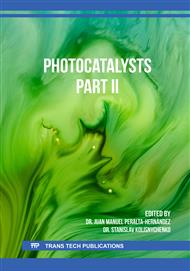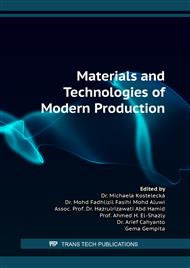p.3
p.11
p.21
p.29
p.39
p.45
p.59
p.71
p.77
Copper Oxide Coupled Titanium Dioxide (CuO/TiO2) Nanocomposite Photocatalyst for Degradation of Methyl Orange Dye
Abstract:
Titanium dioxide (TiO2) was utilized in photocatalysis applications due to their non- toxic, cheap and high photocatalytic activity. However, its photocatalytic reaction is limited by low surface area as well as the rapid recombination of photogenerated electron-hole pairs and only has ability to absorb a small fraction (<5%) of indoor light. In this study, copper oxide coupled titanium dioxide (CuO/TiO2) nanocomposite photocatalyst was synthesized using hydrothermal method. The synthesised photocatalyst was characterized by using Fourier-transform infrared spectroscopy (FTIR), X-ray diffraction analysis (XRD), Scanning electron microscopy(SEM), Brunauer, Emmett, teller (BET) and UV- Visible Spectroscopy. Spectra obtained from FTIR have proved that there are existence of O-H stretching, O-H vibration and metal-O bond that correlates to the functional groups of the samples. As affirmed by XRD analysis, highly crystalline rutile TiO2 phase was obtained for pure TiO2 samples. Rutile TiO2 phase is remained and additional peaks belong to copper oxide was observed for CuO/TiO2 nanocomposite photocatalyst sample. This finding suggesting that copper oxide was successfully loaded onto TiO2. Morphological study from SEM shows the presence of short rod-like particles of copper oxide and agglomerated TiO2 bulk particles. BET surface area for CuO, TiO2 and CuO/TiO2 nanocomposite photocatalysts were 20.50 m2/g, 15.26 m2/g and 17.13 m2/g, respectively. The photocatalytic degradation of methyl orange (MO) was found to be 85.0% using CuO/TiO2 nanocomposite photocatalyst, which is better than pure TiO2 and pure CuO after 3 hours reaction.
Info:
Periodical:
Pages:
39-44
Citation:
Online since:
September 2022
Authors:
Keywords:
Price:
Сopyright:
© 2022 Trans Tech Publications Ltd. All Rights Reserved
Share:
Citation:




